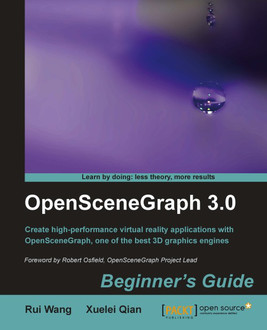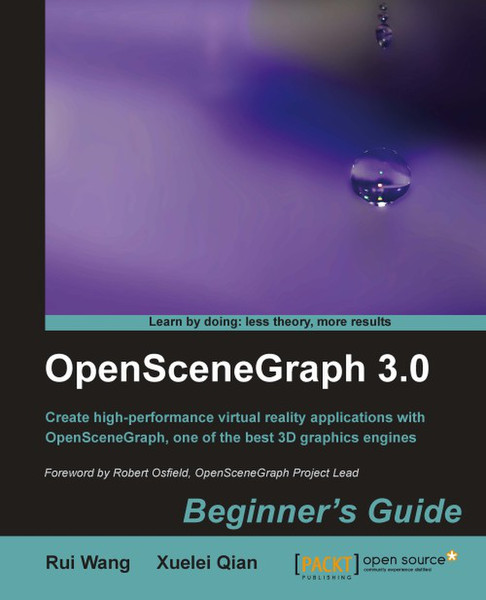目錄的
-
目錄的
- Antiquitäten & Kunst
- Auto & Motorrad: Fahrzeuge
- Baby
- Bücher
- Camping & Outdoor
- Feinschmecker
- Garten & Terrasse
- Haushalt & Wohnen
- Haustierbedarf
- Heimwerken & Garten
- IT和电子
- Kleidung & Accessoires
- Modellbau
- Musik
- PC- & Videospiele
- Sammeln & Seltenes
- Spielzeug
- TV, Video, DVD
- Telekommunikation
- Uhren & Schmuck
- Wellness & Beauty
- fashion & lifestyle
- institutional food services equipment
- medical equipment, accessories & supplies
- 个人护理
- 休闲爱好
- 办公设备,用品和配件
- 商业与工业
- 家居,建筑,装修
- 家用电器
- 摩托车及配件
- 武器和弹药
- 照相机
- 花园和庭院
- 运动,娱乐及休闲
- 食物
- 高保真音響
Filters
Search
Packt OpenSceneGraph 3.0: Beginner's Guide 412pages software manual
EAN: 9781849512824
MPN: 978-1-84951-282-4
发送方式:
交货来源:
德国
凡购买和价格 (Advertising *)
顶部
技术特点
顶部
技术细节
| 分类 | Development software |
|---|---|
| 发行人 | Packt |
| 页数 | 412 pages |
| 作者 | Rui Wang, Xuelei Qian |
另外
| 发布日期 | 12.2010 |
|---|
OpenSceneGraph 3.0: Beginner's Guide
- Gain a comprehensive view of the structure and main functionalities of OpenSceneGraph
- An ideal introduction for developing applications using OpenSceneGraph
- Develop applications around the concepts of scene graphs and design patterns
- Extend your own scene elements from the base interfaces of OpenSceneGraph
- Packed with examples, this book explains each knowledge point in detail and makes you practice your knowledge for better understanding
Virtual reality has quite a lot of demand in computer science today and OpenSceneGraph, being one of the best 3D graphics toolkits, is being used widely. Although you can use the powerful OpenSceneGraph, based on the low-level OpenGL API, to implement virtual-reality applications that simulate different environments in the 3D world, developing picture-perfect applications is easier said than done.
This book has been written with the goal of helping readers become familiar with the structure and main functionalities of OpenSceneGraph (OSG), and guide them to develop virtual-reality applications using this powerful 3D graphics engine. This book covers the essence of OpenSceneGraph (OSG), providing programmers with detailed explanations and examples of scene graph APIs.
This book helps you take full advantages of the key features and functionalities of OpenSceneGraph (OSG). You will learn almost all of the core elements required in a virtual reality application, including memory management, geometry creation, the structure of the scene graph, realistic rendering effects, scene navigation, animation, interaction with input devices and external user interfaces, file reading and writing, and so on.
With the essential knowledge contained in this book, you will be able to start using OSG in your own projects and research fields, and extend its functionalities by referring to OSG's source code, official examples and API documentation.
This handy book divides the core functionalities of the proved and comprehensive OpenSceneGraph (OSG) 3D graphics engine into different aspects, which are introduced in separate chapters. Each chapter can be treated as an individual part that covers one important field of OSG programming, along with several examples illustrating concrete usages and solutions. But the sequence of chapters is also organized from the easy to the more difficult, to help you get to grips with OSG.
By the end of the whole book, you will have gained a ready-to-use OSG development environment for yourself and have the general ability to develop OSG-based applications and extend practical functionalities for your own purposes.
With plenty of examples to get you started quickly, you'll master developing with OpenSceneGraph in no time, the 3D graphics engine based on OpenGL
<b>What you will learn from this book :</b>
- Gain an overview of scene graphs and the basic concepts in OpenSceneGraph (OSG)
- Build and configure an OSG development environment, either with the prebuilt binaries or wholly from the source code
- Understand memory management and the notification system in OSG
- Create geometry entities with vertices and drawing primitives and use these features in your applications successfully
- Make use of various types of scene graph nodes with special focus on some commonly used ones
- Implement different rendering attributes, texture mapping, OpenGL shaders, and render-to-texture technique in OSG
- Understand coordinates, cameras, manipulators, and stereo supports and make them work together
- Create various animated graphics presentations in the 3D scene
- Use mouse and keyboard devices to interact with OSG, as well as integrate other GUI toolkits with OSG rendering windows
- Read scene data and write them out with extendable file I/O plugins
- Develop advanced scene graph components including billboards, texts, height mapped terrains and shadows
- Introduce techniques necessary for building a fast real-time rendering system and help developers work with massive data in a very efficient manner
<b>Who this book is written for</b>
This book is intended for software developers who are new to OpenSceneGraph and considering using it in their applications. It is assumed that you have basic knowledge of C++ before using this book, especially the standard template library (STL) constructs, of which OSG makes extensive use. Some familiarity with design patterns as implemented in C++ is also useful, but is not required.
You need to be familiar with OpenGL, the standard cross-platform low-level 3D graphics API. We'll meet some maths in the book—geometry and linear algebra—and familiarity with these topics will be great, but you don't need to be a maths whiz to use this book.
- An ideal introduction for developing applications using OpenSceneGraph
- Develop applications around the concepts of scene graphs and design patterns
- Extend your own scene elements from the base interfaces of OpenSceneGraph
- Packed with examples, this book explains each knowledge point in detail and makes you practice your knowledge for better understanding
Virtual reality has quite a lot of demand in computer science today and OpenSceneGraph, being one of the best 3D graphics toolkits, is being used widely. Although you can use the powerful OpenSceneGraph, based on the low-level OpenGL API, to implement virtual-reality applications that simulate different environments in the 3D world, developing picture-perfect applications is easier said than done.
This book has been written with the goal of helping readers become familiar with the structure and main functionalities of OpenSceneGraph (OSG), and guide them to develop virtual-reality applications using this powerful 3D graphics engine. This book covers the essence of OpenSceneGraph (OSG), providing programmers with detailed explanations and examples of scene graph APIs.
This book helps you take full advantages of the key features and functionalities of OpenSceneGraph (OSG). You will learn almost all of the core elements required in a virtual reality application, including memory management, geometry creation, the structure of the scene graph, realistic rendering effects, scene navigation, animation, interaction with input devices and external user interfaces, file reading and writing, and so on.
With the essential knowledge contained in this book, you will be able to start using OSG in your own projects and research fields, and extend its functionalities by referring to OSG's source code, official examples and API documentation.
This handy book divides the core functionalities of the proved and comprehensive OpenSceneGraph (OSG) 3D graphics engine into different aspects, which are introduced in separate chapters. Each chapter can be treated as an individual part that covers one important field of OSG programming, along with several examples illustrating concrete usages and solutions. But the sequence of chapters is also organized from the easy to the more difficult, to help you get to grips with OSG.
By the end of the whole book, you will have gained a ready-to-use OSG development environment for yourself and have the general ability to develop OSG-based applications and extend practical functionalities for your own purposes.
With plenty of examples to get you started quickly, you'll master developing with OpenSceneGraph in no time, the 3D graphics engine based on OpenGL
<b>What you will learn from this book :</b>
- Gain an overview of scene graphs and the basic concepts in OpenSceneGraph (OSG)
- Build and configure an OSG development environment, either with the prebuilt binaries or wholly from the source code
- Understand memory management and the notification system in OSG
- Create geometry entities with vertices and drawing primitives and use these features in your applications successfully
- Make use of various types of scene graph nodes with special focus on some commonly used ones
- Implement different rendering attributes, texture mapping, OpenGL shaders, and render-to-texture technique in OSG
- Understand coordinates, cameras, manipulators, and stereo supports and make them work together
- Create various animated graphics presentations in the 3D scene
- Use mouse and keyboard devices to interact with OSG, as well as integrate other GUI toolkits with OSG rendering windows
- Read scene data and write them out with extendable file I/O plugins
- Develop advanced scene graph components including billboards, texts, height mapped terrains and shadows
- Introduce techniques necessary for building a fast real-time rendering system and help developers work with massive data in a very efficient manner
<b>Who this book is written for</b>
This book is intended for software developers who are new to OpenSceneGraph and considering using it in their applications. It is assumed that you have basic knowledge of C++ before using this book, especially the standard template library (STL) constructs, of which OSG makes extensive use. Some familiarity with design patterns as implemented in C++ is also useful, but is not required.
You need to be familiar with OpenGL, the standard cross-platform low-level 3D graphics API. We'll meet some maths in the book—geometry and linear algebra—and familiarity with these topics will be great, but you don't need to be a maths whiz to use this book.
-
支付方式
我们接受:











